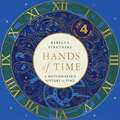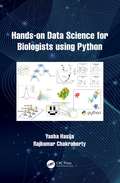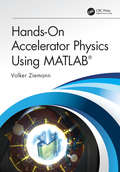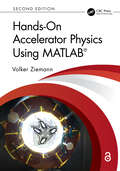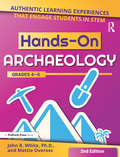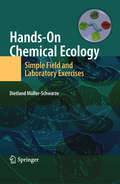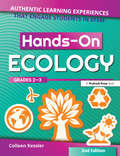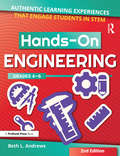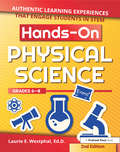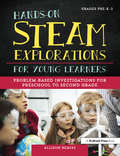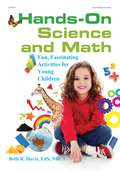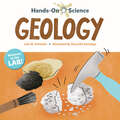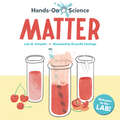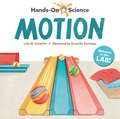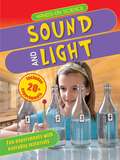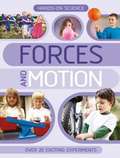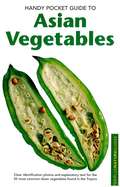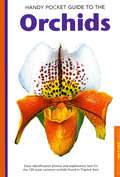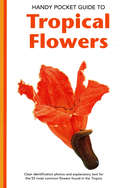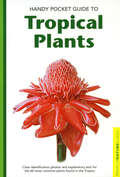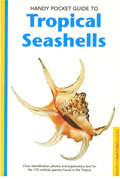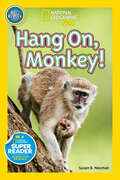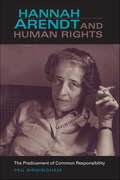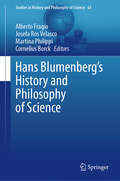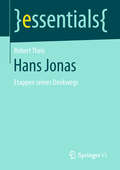- Table View
- List View
Hands of Time: A Watchmaker's History of Time. 'An exquisite book' - Stephen Fry
by Rebecca StruthersA watchmaker's world is not much bigger than a thumbnail.I spend whole days working on mechanisms which can contain hundreds of tiny components. Each of them has a specific task to perform. Every morning when I sit at my bench, it is an adventure into a new timepiece with its own history to lose myself in. And in their history, we can find the history of time itself.Timepieces are one of humanity's most ingenious innovations. Their invention was more significant for human culture than the printing press, or even the wheel. They have travelled the world with us, from the depths of the oceans to the summit of Everest, and even to the Moon. They regulate our daily lives and have sculpted the social and economic development of society in surprising and dramatic ways.In Hands of Time watchmaker and historian Rebecca Struthers welcomes us into the hidden world of watchmaking, offering a personal history of watches that spans centuries and continents. From her workshop bench, Rebecca explores the ways in which timekeeping has indelibly shaped our attitudes to work, leisure, trade, politics, exploration and mortality, and introduces us to some extraordinary and treasured devices, each with their own story to tell.Hands of Time is an intricate and uniquely personal exploration of the history, science, philosophy, and craft of timekeeping.(P) 2023 Hodder & Stoughton Limited
Hands on Data Science for Biologists Using Python
by Yasha Hasija Rajkumar ChakrabortyHands-on Data Science for Biologists using Python has been conceptualized to address the massive data handling needs of modern-day biologists. With the advent of high throughput technologies and consequent availability of omics data, biological science has become a data-intensive field. This hands-on textbook has been written with the inception of easing data analysis by providing an interactive, problem-based instructional approach in Python programming language. The book starts with an introduction to Python and steadily delves into scrupulous techniques of data handling, preprocessing, and visualization. The book concludes with machine learning algorithms and their applications in biological data science. Each topic has an intuitive explanation of concepts and is accompanied with biological examples. Features of this book: The book contains standard templates for data analysis using Python, suitable for beginners as well as advanced learners. This book shows working implementations of data handling and machine learning algorithms using real-life biological datasets and problems, such as gene expression analysis; disease prediction; image recognition; SNP association with phenotypes and diseases. Considering the importance of visualization for data interpretation, especially in biological systems, there is a dedicated chapter for the ease of data visualization and plotting. Every chapter is designed to be interactive and is accompanied with Jupyter notebook to prompt readers to practice in their local systems. Other avant-garde component of the book is the inclusion of a machine learning project, wherein various machine learning algorithms are applied for the identification of genes associated with age-related disorders. A systematic understanding of data analysis steps has always been an important element for biological research. This book is a readily accessible resource that can be used as a handbook for data analysis, as well as a platter of standard code templates for building models.
Hands-On Accelerator Physics Using MATLAB®
by Volker ZiemannHands-On Accelerator Physics Using MATLAB® provides an introduction into the design and operational issues of a wide range of particle accelerators, from ion-implanters to the Large Hadron Collider at CERN. Many aspects from the design of beam optical systems and magnets, to the subsystems for acceleration, beam diagnostics, and vacuum are covered. Beam dynamics topics ranging from the beam-beam interaction to free-electron lasers are discussed. Theoretical concepts and the design of key components are explained with the help of MATLAB® code. Practical topics, such as beam size measurements, magnet construction and measurements, and radio-frequency measurements are explored in student labs without requiring access to an accelerator. <P><P>This unique approach provides a look at what goes on 'under the hood' inside modern accelerators and presents readers with the tools to perform their independent investigations on the computer or in student labs. This book will be of interest to graduate students, postgraduate researchers studying accelerator physics, as well as engineers entering the field. <P><P>Features: <li>Provides insights into both synchrotron light sources and colliders <li>Discusses technical subsystems, including magnets, radio-frequency engineering, instrumentation and diagnostics, correction of imperfections, control, and cryogenics <li>Accompanied by MATLAB® code, including a 3D-modeler to visualize the accelerators, and additional appendices which are available on the CRC Press website
Hands-On Accelerator Physics Using MATLAB®
by Volker ZiemannHands-On Accelerator Physics Using MATLAB®, Second Edition, provides a broad introduction into the physics and the technology of particle accelerators from synchrotron light sources to high-energy colliders. It covers the design of beam optics, magnets, and radio-frequency systems, followed by a discussion of beam instrumentation and correction algorithms. Later chapters deal with the interaction of beams with targets, the emission of synchrotron radiation, and intensity limitations. Chapters discussing running and future accelerators round up the presentation. Theoretical concepts and the design of key components are explained with the help of MATLAB code. Practical topics, such as beam size measurements, magnet construction and measurements, and radio-frequency measurements are explored in student labs that do not require access to an accelerator. This unique approach provides a look at what goes on "under the hood" inside modern accelerators and presents readers with the tools to perform their independent investigations on the computer or in student labs. This book will be of interest to graduate students, post-graduate researchers studying accelerator physics, as well as engineers entering the field.The second edition features a new chapter on future accelerators and several new sections on polarization, neutrino beams, testing of superconducting cavities, and matching in longitudinal phase space, among others.The MATLAB code was updated to be consistent with the recent release of R2024a. All code is available from the book’s GitHub site at https://github.com/volkziem/HandsOnAccelerators2nd.Key features: Provides a broad introduction into physics of particle accelerators from synchrotron light sources to high-energy colliders. Discusses technical subsystems, including magnets, radio-frequency engineering, instrumentation and diagnostics, correction of imperfections, control, vacuum, and cryogenics. Illustrates key concepts with sample code in MATLAB.
Hands-On Archaeology: Authentic Learning Experiences That Engage Students in STEM (Grades 4-5)
by John R. White Mattie OverossHands-On Archaeology immerses students in the world of real-life archaeologists. Through engaging authentic learning experiences, students will discover artifacts from the past and participate in archaeological digs while building STEM skills, as well as making connections to geography, history, art, and English language arts. This book is packed with activities that can easily be conducted in the classroom using everyday materials and includes everything teachers need to help students conduct real-life archaeological digs. From participating in digs in the classroom to conducting digs in the community, students will not just learn about archaeology—they will be archaeologists!Grades 4-5
Hands-On Chemical Ecology:
by Dietland Müller-SchwarzeHands-On Chemical Ecology: Simple Field and Laboratory Exercises, a premiere collection of practical exercises in chemical ecology, offers tools and strategies for understanding this young science. The exercises included use general principles and follow a simple structure. Topics examined include birds, fish, insects, mammals, and plant chemistry among others. Additionally, exercises require accessible materials, ensuring that each can be easily modified and completed anywhere in the world with locally existing instruments. This text will be of value to undergraduate and graduates students and high school biology teachers.
Hands-On Ecology: Authentic Learning Experiences That Engage Students in STEM (Grades 2-3)
by Colleen KesslerHands-On Ecology immerses students in the world of real-life ecologists. Through engaging authentic learning experiences, students will explore ecological habitats while building STEM skills. This book is packed with activities that can easily be conducted in the classroom using everyday materials and includes everything teachers need to help students to explore the makeup of their world, including the animals, plants, and organisms that inhabit it. From studying their local ecosystem to exploring environmentalism and ways they can contribute to conservationism, students will not just learn about ecology—they will be ecologists!Grades 2-3
Hands-On Engineering: Authentic Learning Experiences That Engage Students in STEM (Grades 4-6)
by Beth L. AndrewsHands-On Engineering immerses students in the world of real-life engineers. Through engaging authentic learning experiences, students will create innovative solutions to relevant and timely design and engineering challenges while building STEM skills. This book is packed with activities that can be easily conducted in the classroom using everyday materials and includes everything teachers need to help students think analytically, assess new situations, and solve hands-on, real-world problems. From engaging in practical problem solving and collaboration to employing imagination and perseverance, students will not just learn about engineering—they will be engineers!Grades 4-6
Hands-On Physical Science: Authentic Learning Experiences That Engage Students in STEM (Grades 6-8)
by Laurie E. WestphalHands-On Physical Science immerses students in the world of real-life chemists and physicists. Through engaging authentic learning experiences, students will engage in fascinating experiments while building STEM skills. This book is packed with activities that can easily be conducted in the classroom using everyday materials and includes everything teachers need to help students think critically and problem solve as they explore the fascinating world of physical science. From examining Newton's laws using sports video clips to studying energy through the design and building of roller coasters, students will not just learn about physical science—they will be scientists!Grades 6-8
Hands-On STEAM Explorations for Young Learners: Problem-Based Investigations for Preschool to Second Grade
by Allison BemissHands-On STEAM Explorations for Young Learners: Problem-Based Investigations for Preschool to Second Grade uses popular children's nursery rhymes to explore STEAM concepts through minds-on, hands-on investigations. Children ages 4-8 and their teachers will love this twist on familiar old nursery rhymes. Children will enjoy problem solving and tinkering as they discover and explore. Baa, Baa, Black Sheep insists that she hides more colors in the drawn lines of her black wool. Test to find out if it is possible for black to be more than one color. How might you make Old King Cole's fiddle using cardboard boxes and rubber bands? Teachers will appreciate the easy-to-follow layout, connections to advanced learning, and easy-to-access materials in each investigation. Innovation, wonder, and fun are at the heart of each of these explorations.Grades Pre-K-2
Hands-On Science and Math: Fun, Fascinating Activities for Young Children
by Beth R. DavisEncourage young investigators to feel, listen, smell, taste, and see their way to discovery by seamlessly infusing math and science throughout the school day! As you incorporate all five senses into learning experiences, you will give little innovators the opportunity to observe and explore the world around them. The activities in Hands-On Science and Math: Fun, Fascinating Activities for Young Children will help you plan engaging science, technology, engineering, and math (STEM) lessons that will excite children and foster their critical thinking. Children can experience the thrill of scientific inquiry through simple experiments. Designed to work with easy-to-find materials, the Hands-On Science and Math activities are inexpensive and uncomplicated, yet they lay the groundwork for understanding more complex STEM concepts later on.
Hands-On Science: Geology (Hands-On Science)
by Lola M. SchaeferPress Here meets Bill Nye the Science Guy in this interactive STEM picture book about rocks, minerals, and Earth science.Welcome to the geology lab! In this interactive picture book, young scientists use their imagination to bring experiments to life. They slide tectonic plates together to create earthquakes, blow on a mountain to make a volcano erupt, and press their hands in mud to make a fossil. After predicting what will happen next, eager readers turn the page to see the results.Educator and author Lola M. Schaefer draws on her years in the classroom to make science fun and accessible. Back matter includes a simple experiment for investigating rocks and minerals in the real world.
Hands-On Science: Matter (Hands-On Science)
by Lola M. SchaeferPress Here meets Bill Nye the Science Guy in this interactive STEM picture book about solids, liquids, and gases, bringing science experiments to life.Welcome to the chemistry lab! Through imagination, exploration and play, readers see that matter comes in all shapes and sizes and can change from solid to liquid to gas. Each page of this engaging book instructs the reader to smash clay to change its shape, tilt the book to pour liquid, or blow to make bubbles, bringing the science experiments to life. After predicting what will happen next, eager readers turn the page to see the results.Educator and author Lola M. Schaefer draws on her years in the classroom to make science fun and accessible through engaging and playful text. Back matter includes a simple experiment for investigating matter in the real world.
Hands-On Science: Motion (Hands-On Science)
by Lola M. SchaeferPress Here meets Bill Nye the Science Guy in this interactive STEM picture book about forces and motion.Welcome to the physics lab! In this picture book, young scientists use their imagination to bring experiements to life. They poke whipped cream in the illustrations, tilt the book to roll a ball down a ramp, and slide beanbags to test friction. After predicting what will happen next, eager readers turn the page to see the results.Educator and author Lola M. Schaefer draws on her years in the classroom to make science fun and accessible. Back matter encourages kids to notice the pushes and pulls all around them and includes a simple physics experiment.
Hands-On Science: Sound and Light
by Jack ChallonerSound and light may seem like things we know everything about, but by conducting the easy to navigate science experiments in Hands-On Science: Sound and Light, young learners will see that there is much more than meets the eye. Through these informative and easy to conduct experiments and activities, budding scientists will discover the interesting and often-changing characteristics of materials in their everyday world.
Hands-on Science: Forces and Motion
by John GrahamHave you ever wondered why things move the way they do? What makes them start moving? Why do things fall when you drop them? Why is swimming so much harder than walking? You will discover answers to these questions, and many others, in this book. It is packed full of experiments to try out at home or at school, which will help you to understand forces and motion.
Handy Pocket Guide to Asian Vegetables
by Wendy Hutton Peter MealinThis handy field guide introduces over 50 tropical vegetables commonly found in Indonesia. Each exotic item is described in detail, and local names as well as botanical names are given. Culinary options, tips on buying, storing and preparation of vegetables, and five mouth watering recipes are included. Illustrated with beautiful color photographs for easy identification of each vegetable, this book is a "must" for vegetable lovers.
Handy Pocket Guide to Orchids
by David P. BanksFeatures over 120 orchid species found in Southeast Asia and contains more than 130 color photographs.
Handy Pocket Guide to Tropical Flowers
by Luca Invernizzi Tettoni William WarrenFeatures the most brilliant blooms and blossoms from the tropics and includes scientific, family and common names of each flower in Indonesian, Malay and Thai.
Handy Pocket Guide to Tropical Plants
by Luca Invernizzi Tettoni Elisabeth ChanIntroduces more than 60 different plant species found in Asia.
Handy Pocket Guide to Tropical Seashells
by Pauline Fiene-Severns Ruth Dyerly Mike SevernsFeatures 170 mollusks from Southeast Asia with information on their habitat and behavior.
Hang On, Monkey! (Readers)
by Susan B. NeumanHang On, Monkey! uses simple vocabulary and fun pictures to capture the interest and help develop the skills of beginning readers. The crazy antics, humor, and fun information make this new reading experience a treat.
Hannah Arendt and Human Rights: The Predicament of Common Responsibility (Studies in Continental Thought)
by Peg BirminghamHannah Arendt's most important contribution to political thought may be her well-known and often-cited notion of the "right to have rights." In this incisive and wide-ranging book, Peg Birmingham explores the theoretical and social foundations of Arendt's philosophy on human rights. Devoting special consideration to questions and issues surrounding Arendt's ideas of common humanity, human responsibility, and natality, Birmingham formulates a more complex view of how these basic concepts support Arendt's theory of human rights. Birmingham considers Arendt's key philosophical works along with her literary writings, especially those on Walter Benjamin and Franz Kafka, to reveal the extent of Arendt's commitment to humanity even as violence, horror, and pessimism overtook Europe during World War II and its aftermath. This current and lively book makes a significant contribution to philosophy, political science, and European intellectual history.
Hans Blumenberg's History and Philosophy of Science (Studies in History and Philosophy of Science #63)
by Cornelius Borck Josefa Ros Velasco Alberto Fragio Martina PhilippiThis book highlights and develops a hitherto neglected area of Hans Blumenberg's contributions, i.e., history and philosophy of science. It covers both Blumenberg’s works on the history of ideas and conceptual change, as well as his studies on transformative periods and his intellectual history of technology. Hans Blumenberg (1920-1996) was one of the leading German philosophers after the Second World War, bridging from the continental tradition of philosophy, conceptual history and metaphorology. This volume, though, explores the methodological instruments that he developed and how we may use them to do history and philosophy of science. In doing so it opens up a new field of research and provides insight into further developing a continental history and philosophy of science, making this book of great interest to both historians and philosophers alike.
Hans Jonas: Etappen seines Denkwegs (essentials)
by Robert TheisDieses essential widmet sich dem Werk des Philosophen Hans Jonas und zwar aus dem Blickwinkel der Entwicklung seines Denkens. Die frühen Studien über die spätantike Gnosis bilden den Ausgangspunkt. Hier stößt Jonas auf ein Thema, das er in seinem gesamten späteren Werk kritisch diskutiert, nämlich das des weltfeindlichen Dualismus. In den ab den 1940er-Jahren entworfenen Studien zu einer philosophischen Biologie wird der Versuch unternommen, den Menschen in seiner leib-geistigen Verfasstheit bis hin zu seinen höchsten symbolischen Ausdrucksformen aus dem Prozess der gesamten Evolution heraus zu deuten und damit implizit die Weltfeindlichkeit der Gnosis zu widerlegen. In seiner Ethik der Verantwortung, die er in dem 1979 veröffentlichten berühmten Prinzip Verantwortung systematisch vorträgt, findet sich gleichsam die ethische Seite der Überwindung der Gnosis, nämlich, dass der Mensch Verantwortung für eine Welt zu übernehmen habe, in der auch zukünftige Generationen menschenwürdig leben können. In seinen letzten metaphysisch-theologischen Vermutungen dann wird die Problematik der Verantwortung mit Blick auf einen in der Schöpfung selber werdenden Gott hin thematisiert.
